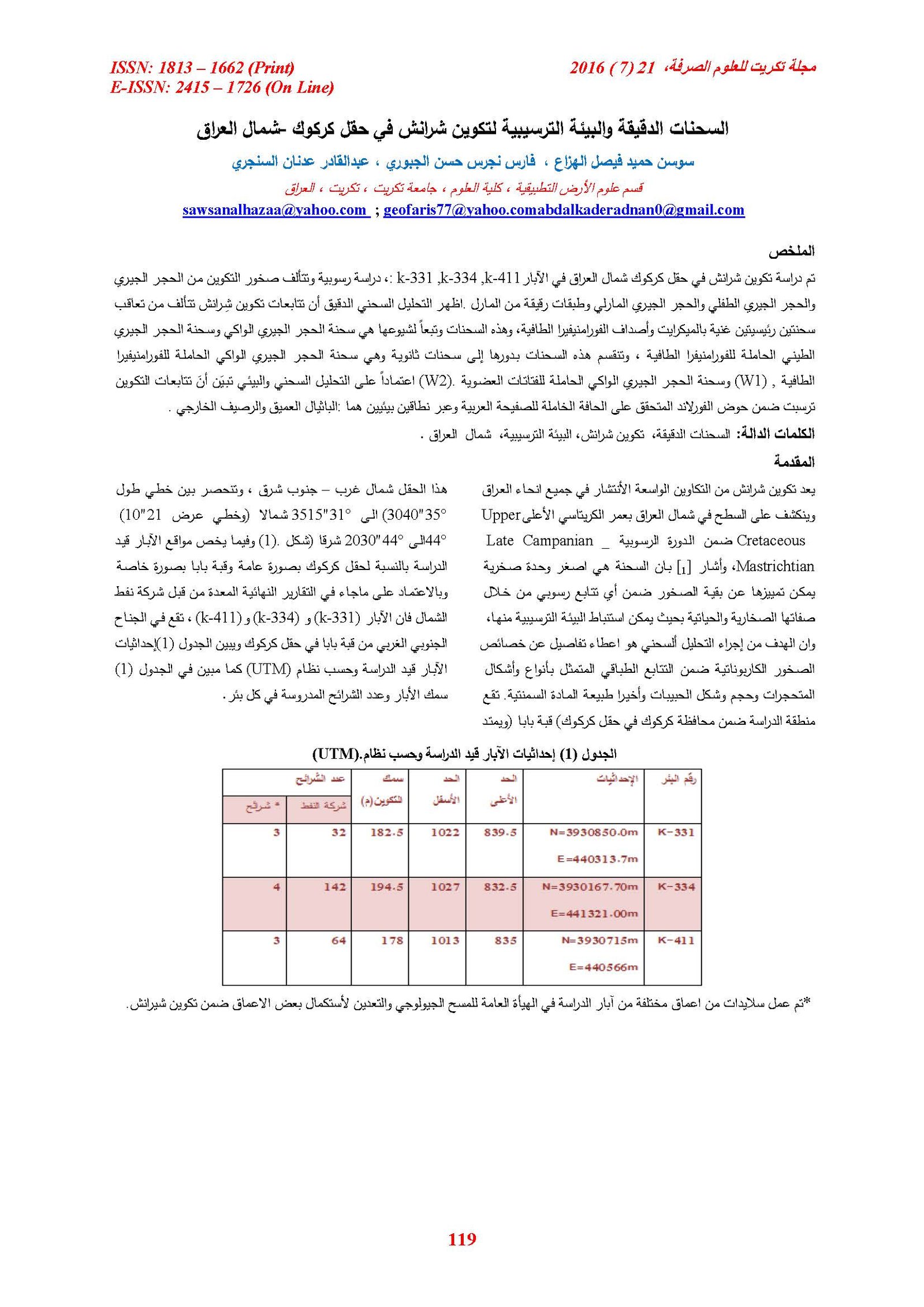Microfacies and depositional environment of Shiranish Formation in kirkuk Oil fields north Iraq
Main Article Content
Abstract
This study is reveal the characteristics of Shiranish Formation to elucidate the sedimentological properties of Kirkuk Oil fields north of Iraq from wells k-331, k-334, k-411. The studied rocks are consist of limestone, shaley limestone, marly limestone and thin bedded of marl. Facies analysis showed that the exact composition of Shiranish sequences composed of three facies succession of President rich Balmikarait and shells Alforamenavera floating. These facies and depending on popularity are Lime Wackestone Microfacies and Lime Mudstone Microfacies, these facies are divided in turn into secondary facies which Planktonic Foraminiferal Lime Wackestone Submicrofacies (W1), and Bioclastic Lime Wackestone Submicrofacies (W4). Depending on Facies and environmental analysis shows that the composition of sequences have deposited within the basin foreland achieved on the inactive edge Arabian plate and deposited in deep bathyal and out shelf environment
Article Details

This work is licensed under a Creative Commons Attribution 4.0 International License.
Tikrit Journal of Pure Science is licensed under the Creative Commons Attribution 4.0 International License, which allows users to copy, create extracts, abstracts, and new works from the article, alter and revise the article, and make commercial use of the article (including reuse and/or resale of the article by commercial entities), provided the user gives appropriate credit (with a link to the formal publication through the relevant DOI), provides a link to the license, indicates if changes were made, and the licensor is not represented as endorsing the use made of the work. The authors hold the copyright for their published work on the Tikrit J. Pure Sci. website, while Tikrit J. Pure Sci. is responsible for appreciate citation of their work, which is released under CC-BY-4.0, enabling the unrestricted use, distribution, and reproduction of an article in any medium, provided that the original work is properly cited.
References
[1] Friedman, G.M. and Sanders, J.E., (1978) Principle of Sedimentology. John Wiley and sons. 792P.
[4] Jassim, S. Z. and Buday, T. (2006) : Late Turonian – Danian Megasequence Ap9, In : Jassim, S. Z. and Goff, J. C.(Eds), Geology of Iraq,
Published by Doline, Prague and Moravian Museum, Brno, PP. 141– 154.
[5] Van Bellen, R.C., Dunnington, H.V., Wetzel, R., and Morton, D. M., 1959, Lexique Stratigraphique Internal Asie , Vol. 3, Fasc. 109, Iraq, Paris, 333 P.
[6] Al-Rawi, D. (1973): A contribution to the geology of Jebel Sinjar Zone. Geol. Wiss. Berlin, Vol. 1, No. 2, pp.1441-1447.
[7] Buday, R.T., 1980: The Regional Geology of Iraq, 1, Stratigraphy and Paleogeography,in Kassab, I.I.M. & Jassim, S.Z. (ed). SOM, Baghdad, 445p.
الع ا رق، رسالة ماجستير غير منشور ، جامعة تكريت، 92 صفحة . [10] Dunham, R.j.,1962, Classification of Carbonate rocks according to depositional texture,in Ham W.E. (ed) Amposium AAPG Bull. Pub. Memmoir, Talusa, Oklahoma, PP.108-121.
[11] Flugel, E., 1982, Microfacies Analysis of Limestone ,Springer Verlag Berlian,633P.
[12] Wilson, J.L., 1975, Carbonate Facies in Geologic History, Springer Verlag ,Berlin,470P.
[13] Flugel, E., (2004): Microfacies of Carbonate Rocks, Analysis, Interpretation and Application, Springer, Berlin, Hiedeiberg, New York,966p.
[14] Leckie, R.M., 1987: Paleoecology of mid–Cretaceous planktonic foraminifera: A comparison of open ocean and epicontinental sea assemblages. Micropaleontology, Vol. 33, No. 2, pp. 164–176.
[15] Koutsoukos, A.M. and Hart, M. B., 1990: Cretaceous foraminiferal morphogroub distribution patterns palaeocommunities and trophic structures: A case study from the Sergipe Basin, Brazil. Transaction of the Royal Society of Edinburgh: Earth sciences, Vol. 81, pp. 221-246.
[16] Omana, L., 2006: Late Cretaceous (Maastrichtian) foraminiferal assemblage from the inoceramid beds, Ocozocoautla Formation, Central Chiapas, SE Mexico. Revista Mexicana de Ciencias Geologicas, Vol. 23, No. 2, pp. 125–132.
[17] Hart, M. B., (1980). A water depth model for evolution of the planktonic foraminiferida, Nature, No. 286, pp.252-254.
[18] Sliter, W.V. and Baker, R.A., 1972: Cretaceous bathymetric distribution of benthic foraminiferas. Journal of Framiniferal Research, Vol. 2, No. 4, pp. 167–183.
[19] Abdel-Kireem, M. R.(1983): A study of the Paleoecology and Bathymetry of the Foraminiferal Assemblages of the Shiranish Formation (Upper Cretaceous) Northeastern Iraq, Palaeogeography Palaeoclimatology. Paleoecology., Vol.43, pp.169-180.
